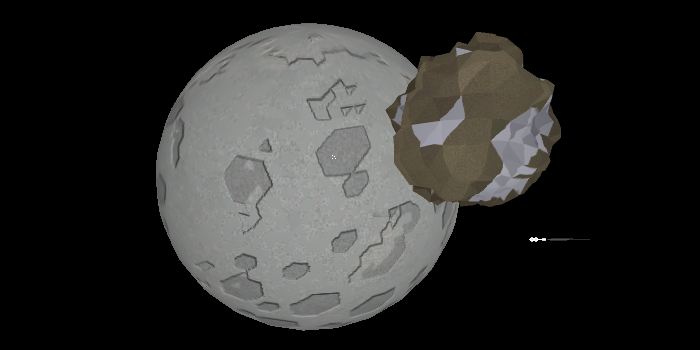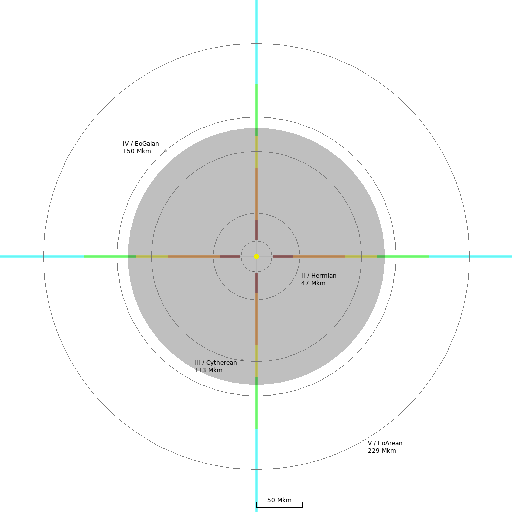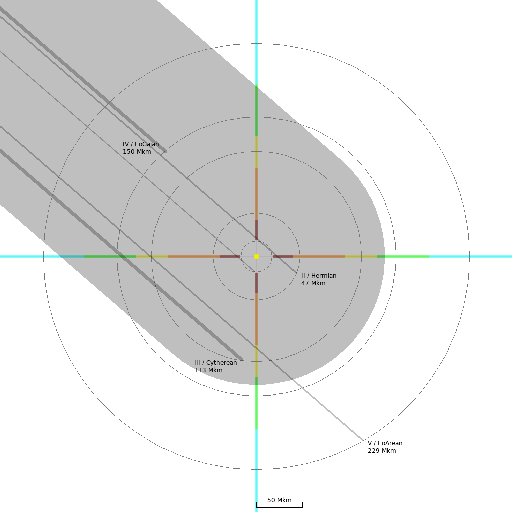Jump Preservation

So I’ve been thinking about how Jumps between (or even within) star systems works in a Traveller-like setting for my YAGS rules, especially in terms of preserving energy and momentum. Since I’ll be running things from software, coming up with something that involves non-trivial maths isn’t a problem. However, I’m still sticking to the 2D nature of a Traveller universe, at least for now.

The first thing to consider is that every system will have bubbles in which a jump isn’t possible, known as Jump Masks.
A mask surrounds every object out to a distance based on the mass of that object. In Traveller, the mask is based on 100 diameters of the object, which means a solar mass white dwarf has a jump mask about the same size as Earth, which makes no sense. Basing it on mass so it approximates Traveller is easy enough to do if you have software to work out navigation, and makes much more sense from a physics perspective. The mask means that not only can you not Jump directly to a planet, but you will often not be able to Jump directly into the inner solar system, since the Jump Mask of the star can encompass the inner worlds. Sol’s mask is just under 1 AU, so it covers Mercury and Venus, but not Earth.

It’s also not possible to jump through a mask, so each mask creates a Jump Shadow behind it. In the diagram to the right, a ship leaving a planet in the upper left, that wants to jump to a destination to the lower right, will have to first move out of the jump shadow to get a clear jump. Likewise a ship jumping in from a system from the lower right will not be able to jump directly into any part of the destination system covered by the shadow.
This limits where in an orbit it is possible to jump to directly, and may affect the viability of trade routes for part of the year. Gas giants may produce shadows which temporarily block planets behind them, but these will generally be short lived.
One question that does arise is that of asteroid belts, since each individual asteroid will create a shadow behind it. Given just how empty most asteroid belts are though, these can probably just be ignored. It’s possible that there’s a low, unpredictable, risk of hitting a shadow when jumping across asteroid belts though.
Most of this is basic Traveller. So what happens when a ship comes out of Jump? How fast is it moving, and in which direction? Is momentum conserved?
My problem with conservation of momentum (from a game perspective) is two fold. Firstly, with low tech ships, it can make it very hard to actually get to your destination. Earth moves at 30km/s in its orbit, so if you jump from Earth to a nearby system to a planet that is moving at 30km/s in the opposite direction, you need 60km/s of delta-v to just match velocity with your destination world, let alone reach it and enter orbit. That’s more than most early interstellar ships are capable of in my setting.
Secondly, if you don’t kill your velocity, you have a 30km/s kinetic kill weapon. At higher TLs, you can accelerate up to very high velocities before you Jump to turn any ship into a very deadly weapon that can’t be easily spotted and stopped. I’d prefer to avoid that.
Fixing these means we lose preservation of momentum, but we already don’t have preservation of potential energy, so it’s not as if we’re not already breaking physics. It’s possible to handwave that a Jump sheds/gains access energy from Jump space. More on this later.
So my plan is that when a ship comes out of Jump space, its velocity is changed to match the orbital velocity of its destination. If it comes out near Earth’s orbit, it will be moving at 30km/s in an orbit around the Sun (or even in a very high orbit around the Earth). A Jump exit point always matches the local movement in Space which will put the ship in a stable orbit. I’m not certain I want to go into details on the exact specifics of how this happens, but in practice you always come out in a reasonable orbit which is both convenient for navigation and difficult to weaponise.
The energy difference in momentum from the point of origin to the destination needs to be shed – and this can make the Jump harder, increasing the difficulty of the navigation check. It’s not hugely difficult, but it can increase the chance of minor mishaps. Large differences in potential energy also have an effect on this, so a ship may need to ensure its distance of exit at the target star is similar to the distance of entry at source. The mass of the two stars will also affect this.
The sensitivity of a jump drive to this will be reduced as technology improves, so a TL 10 ship (the point at which jump drives are invented) will need to navigate a course that comes out with roughly similar momentum and potential energy, whilst a TL 16 ship will have a lot more freedom to go where it wants. High tech ships will also be able to jump closer to a planet or star, though by TL 16 (about the maximum available) you’ll still be looking at hundreds of thousands of kilometres from an Earth sized planet.
So by the time civilisations reaches an ‘Imperium’ level of technology, where TL 14-15 is common, most ships, if the planetary orbits are right, will be able to jump out near to their planetary destination, and then perform a small leisurely burn to enter low orbit.
You will still be able to put military bases or pirate outpost deep in the inner solar system though where no ship can jump to directly. Settlements here may be avoided for trade purposes, but will be protected from sudden surprise attack because of the star’s jump mask.
It won’t even be possible to jump into the outer system and just ‘fall in’ – you’ll come out in a circular orbit and will need to perform a highly visible burn to change your orbit to take you into the inner system. The best you could do for a surprise attack against any target with any form of space surveillance would be to jump in as close as possible, then burn as hard as you can to reach the target as quickly as feasible to give them minimum time to prepare.